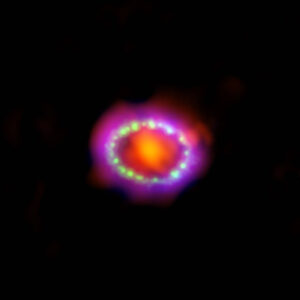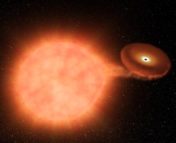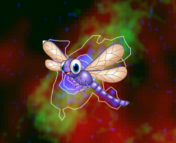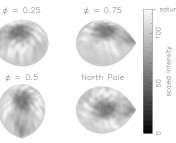
This guest post was written by Sonja Panjkov, PhD student at the University of Melbourne. Sonja’s research focuses on the supernova remnants in the Magellanic Clouds, which she studies at X-ray and radio wavelengths. Outside of astronomy, Sonja enjoys trying new foods and playing with her cats.
Authors: Emanuele Greco, Marco Miceli, Salvatore Orlando, Barbara Olmi, Fabrizio Bocchino, Shigehiro Nagataki, Lei Sun, Jacco Vink, Vincenzo Sapienza, Masaomi Ono, Akira Dohi, Giovanni Peres
First Author’s Institution: Anton Pannekoek Institute for Astronomy, University of Amsterdam, The Netherlands
Status: Published in The Astrophysical Journal [open access]
When the famed Supernova 1987A (SN 1987A) exploded on 23 February 1987 in the Tarantula Nebula of the Large Magellanic Cloud, it provided a valuable opportunity to probe the final stages of stellar evolution.

SN 1987A’s potential to reveal the hidden nature of core-collapse supernovae was almost immediately apparent. For the first time, the neutrino burst expected from the core-collapse of massive stars was detected at three neutrino observatories around the world and provided solid evidence of a neutron star at the heart of SN 1987A.
However, the postulated neutron star has long remained elusive as it can be camouflaged by the cold, dense supernova material in the way. Or at least that was the case until evidence of SN 1987A’s central neutron star was published, led by researchers at the University of Amsterdam, who searched for emission from its associated pulsar wind nebula.
Pulsar wind nebulae are the powerful winds from rapidly rotating neutron stars, which accelerate charged particles to relativistic velocities and emit high-energy X-rays. Thus, the identification of a pulsar wind nebula within SN 1987A would solve the mystery of its missing neutron star.
Is a Pulsar Wind Nebula Hidden in the X-ray Spectrum of SN 1987A?
Building on the results from an earlier paper covered in this astrobite, the authors of today’s paper searched for traces of SN 1987A’s pulsar wind nebula. To do this, they conducted a simultaneous analysis of X-ray observations captured by Chandra, XMM-Newton and NuSTAR, spanning eight years of SN 1987A’s evolution.
In the earlier paper, the authors analysed two years of X-ray data and found evidence of high-energy X-ray emission from SN 1987A, however they were unable to determine the precise nature of the source. With the addition of more recent data, the authors of today’s paper were not only able to detect high-energy X-ray emission, but they were also able to identify its likely origin.
The authors first determined whether certain features of the X-ray spectrum may be attributed to a pulsar wind nebula by testing two different models.
The first model they consider is the 3-kT model, which does not account for a central pulsar wind nebula. The second model they test is called the 3-kT plus power-law model. It adds a heavily absorbed power-law component to the 3-kT model to describe the emission from a pulsar wind nebula that is blocked by the intervening cold, dense supernova material. If the 3-kT plus power-law model provides a better fit to the data, it’s likely there is a pulsar wind nebula at the heart of SN 1987A!
The results using the 2014 data are shown in Figure 2, with the spectra in the top panes and residuals below. Residuals tell you how well your model replicates your observations, with a residual of 0 indicating a perfect fit.

On the left, the data are fitted with the 3-kT model that does not account for a pulsar wind nebula, while on the right they fit the 3-kT plus power-law model. Evidently, both models do a good job of replicating the observations up until roughly 8 keV, however it is at the high energy end of the spectrum that things become interesting.
For the 3-kT model, the residuals are significantly greater than 0 above 8 keV, while they disappear for the model that accounts for a pulsar wind nebula. Thus, the 3-kT plus power-law model provides the better fit, and it is likely that a hidden pulsar wind nebula is indeed altering the X-ray spectrum of SN 1987A above 8 keV!
Could it be a Pulsar Wind Nebula Imposter?
What makes this work even more exciting is that the authors rule out the other possible explanation for this high-energy emission, namely diffusive shock acceleration, which accelerates particles to high energies at supernova shock fronts. Diffusive shock acceleration would also be described by a power-law model, however it would be distinct from the pulsar wind nebula scenario due to the different physical sites where these processes occur.
More specifically, the high-energy emission from diffusive shock acceleration would be unabsorbed, since it occurs at the periphery of SN 1987A where there is no supernova material blocking our line of sight. In comparison, the emission from a pulsar wind nebula would be highly absorbed due to its origins deep within the supernova remnant.
To distinguish between these scenarios, the authors again test two models: one with a highly absorbed power-law, representing the emission from a central pulsar wind nebula, and another with an unabsorbed power-law, representing the high-energy emission that would result from diffusive shock acceleration.
They find that the best fit to the observational data occurs when heavy absorption is included, suggesting that the source of the high-energy emission is located at the heart of SN 1987A. Exactly where we would expect to see the elusive neutron star!
Even though the neutron star in SN 1987A remains hidden, there’s good evidence for its existence in the X-ray spectrum if you look close enough. Excitingly, as SN 1987A ages and expands, a direct detection of its neutron star may become possible by the 2030s. All that’s left to do is wait.
Astrobite edited by Emma Foxell




